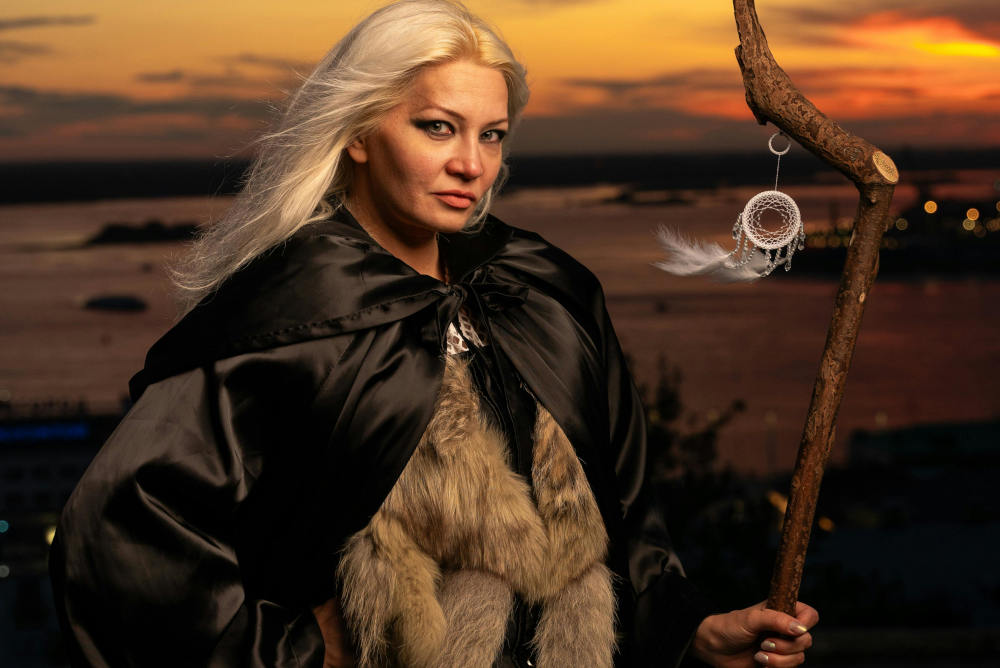
Das Wort „Druide“ ruft Bilder von gekleideten Weisen in heiligen Hainen hervor, die Rätsel lösen, mit der Natur kommunizieren und über Generationen hinweg verborgenes Wissen bewahren. Obwohl vieles, was wir über die alten Druiden wissen, durch die Linse römischer Historiker gefiltert oder aus Mythen, Archäologie und mündlicher Überlieferung rekonstruiert wurde, ist eines klar: Die Druiden spielten eine zentrale Rolle im spirituellen und kulturellen Leben der alten keltischen Gesellschaften.
Dieser Artikel untersucht die Grundüberzeugungen der alten Druiden – wer sie waren, was sie glaubten, wie sie ihre Praktiken ausübten und wie ihre Weltanschauung die Zivilisationen des Europas der Eisenzeit prägte.
Panaprium ist unabhängig und wird vom Leser unterstützt. Wenn Sie über unseren Link etwas kaufen, erhalten wir möglicherweise eine Provision. Wenn Sie können, unterstützen Sie uns bitte monatlich. Die Einrichtung dauert weniger als eine Minute und Sie werden jeden Monat einen großen Beitrag leisten. Danke schön!
Wer waren die Druiden?
Die Druiden waren die intellektuelle, religiöse und juristische Klasse der keltischen Völker im alten Britannien, Irland, Gallien (dem heutigen Frankreich) und anderen Teilen Westeuropas. Sie waren nicht nur „Priester“, sondern auch Philosophen, Richter, Dichter und Wissenschaftler. Römischen Schriftstellern wie Julius Cäsar zufolge hatten die Druiden enormen Einfluss auf die keltischen Stämme und dienten als Erzieher, Berater der Könige und Hüter heiligen Wissens.
Die Kelten selbst hinterließen keine schriftlichen Aufzeichnungen – die Druiden glaubten, dass Wissen mündlich weitergegeben werden sollte – daher stammt das meiste, was wir wissen, aus externen Berichten und späteren mythologischen Texten.
Grundüberzeugungen der alten Druiden
1. Ehrfurcht vor der Natur
Im Mittelpunkt des druidischen Glaubens stand eine tiefe Verbundenheit mit der Natur. Druiden betrachteten alle Aspekte der Natur – Bäume, Flüsse, Berge, Tiere – als lebendig, voller Geist und heiliger Kraft. Die Natur war nicht vom Göttlichen getrennt, sondern ein Ausdruck davon.
Heilige Haine, bekannt als Nemeton , waren ihre Tempel. Man glaubte, dass diese Wälder von Göttern, Geistern oder Ahnen bewohnt wurden. Besonders Eichen wurden besonders verehrt. Das Wort „Druide“ könnte sich vom protokeltischen Wort dru-wid ableiten, was „Eichenkenner“ oder „Weiser der Eiche“ bedeutet.
Druiden glaubten, dass das Verständnis der Natur das Verständnis der göttlichen Ordnung des Universums bedeute.
2. Animismus und Polytheismus
Die druidische Spiritualität war animistisch und polytheistisch:
-
Animismus : Sie glaubten, dass alle Elemente der natürlichen Welt Geister enthielten – Bäume, Felsen, Flüsse und Tiere hatten ein Bewusstsein oder heilige Energie.
-
Polytheismus : Druiden verehrten viele Götter und Göttinnen, die oft mit Naturgewalten, Stammeszugehörigkeit oder bestimmten Regionen verbunden waren. Gottheiten wie Lugh (Gott des Lichts und der Geschicklichkeit), Brigid (Göttin der Poesie und Heilung) und Cernunnos (der gehörnte Gott des Waldes) waren zentrale Figuren im keltischen Glauben.
Anders als die anthropomorphen Götter der griechisch-römischen Religion hatten keltische Gottheiten oft fließende, formwandelnde Eigenschaften und waren eng mit dem Land verwoben.
3. Die Heiligkeit der Zahl Drei
Die Zahl Drei war zentral für den Glauben und die Symbolik der Druiden. Sie stand für Harmonie, Gleichgewicht und die Verbundenheit aller Existenzen. Viele Aspekte ihres spirituellen Systems spiegelten dies wider:
-
Drei Welten : Die Kelten glaubten an drei Reiche – die Oberwelt (göttlich/geistig), die Mittelwelt (irdisches Leben) und die Unterwelt (angestammtes/spirituelles Reich).
-
Dreifache Gottheiten : Viele Götter und Göttinnen erschienen in Triaden, wie beispielsweise die Morrígan , eine Kriegsgöttin, die als drei Schwesteraspekte erschien.
-
Awen : Das druidische Symbol der drei Lichtstrahlen (☰) steht für Inspiration, Gleichgewicht und spirituelles Erwachen. Es wird auch heute noch im modernen Druidentum verwendet.
Die druidische Weltanschauung
1. Die Unsterblichkeit der Seele und die Wiedergeburt
Einer der markantesten Glaubensvorstellungen der Druiden war ihre Lehre von der Reinkarnation bzw. Seelenwanderung . Julius Cäsar schrieb, die Druiden lehrten, dass die Seele nicht vergeht, sondern nach dem Tod in einen anderen Körper übergeht.
Dieser Glaube diente möglicherweise dazu, die Angst vor dem Tod zu verringern und Tapferkeit im Kampf zu fördern. Druiden glaubten, dass die Seele verschiedene Leben durchlief, um zu wachsen und zu lernen – möglicherweise unter Menschen, Tieren oder sogar Elementarkräften –, bevor sie in die Geisterwelt zurückkehrte.
2. Zeit und Zyklen
Druiden betrachteten die Zeit als zyklisch , nicht linear. Leben, Tod und Wiedergeburt waren Teil eines ewigen Kreislaufs, der sich in der Natur widerspiegelte. Der Wechsel der Jahreszeiten, der Mondkalender und die landwirtschaftlichen Rhythmen von Aussaat und Ernte waren fester Bestandteil ihrer spirituellen Philosophie.
Das Jahresrad – obwohl erst viel später formalisiert – wurzelte in alten keltischen Bräuchen. Zu den wichtigsten saisonalen Festen gehörten:
-
Samhain (Ende der Ernte, Ehrung der Toten)
-
Imbolc (erste Anzeichen des Frühlings)
-
Beltane (Fruchtbarkeits- und Feuerfest)
-
Lughnasadh (erste Ernte)
Dabei handelte es sich nicht nur um kulturelle Feste, sondern auch um spirituelle Rituale zur Feier der heiligen Wende der Erde.
3. Gleichgewicht und Harmonie
Im Mittelpunkt der druidischen Ethik stand die Wahrung von Gleichgewicht und Harmonie – mit der Natur, der Gemeinschaft und dem Kosmos. Druiden fungierten als Vermittler, lösten Konflikte und sorgten für Gerechtigkeit. Sie betrachteten die Welt als lebendiges Netz, in dem ein Ungleichgewicht in einem Bereich das Ganze beeinträchtigen konnte.
Zu ihren Aufgaben gehörte es, Omen zu deuten, Naturzeichen zu verstehen und Führer in Fragen des Rechts, des Krieges und des Friedens zu beraten – alles aus der Perspektive der Wiederherstellung oder Bewahrung der Harmonie.
Rituale und Praktiken
1. Mündliche Überlieferung und Auswendiglernen
Druiden weigerten sich, ihre Lehren niederzuschreiben. Laut Caesar konnten Schüler bis zu 20 Jahre lang studieren und Verse, Mythen, Gesetze und spirituelle Lehren auswendig lernen. Diese mündliche Überlieferung bewahrte kulturelles Wissen, stellte aber auch sicher, dass spirituelle Weisheit heilig und exklusiv blieb.
Diese Methode spiegelte ihre Überzeugung wider, dass Wissen lebendig ist und durch Atem, Stimme und Erfahrung weitergegeben werden sollte, anstatt schriftlich festgehalten zu werden.
2. Wahrsagen und Weissagungen
Druiden praktizierten verschiedene Formen der Wahrsagerei , um Einblicke in die Geisterwelt oder die Götter zu gewinnen. Dazu gehören beispielsweise:
-
Den Flug der Vögel beobachten
-
Untersuchung von Tierinnereien (eine aus römischen Berichten bekannte Praxis)
-
Auf Omen in Naturphänomenen wie Blitzen, Stürmen oder Träumen hören
Solche Praktiken dienten als Entscheidungshilfe in der Schlacht, in der Landwirtschaft, als Führungspersönlichkeit und bei der zeitlichen Planung von Ritualen.
3. Opfer und Gaben
Einige historische Quellen (wie Caesar und Tacitus) behaupten, dass Druiden Tier- und sogar Menschenopfer darbrachten, obwohl die Genauigkeit und Häufigkeit dieser Behauptungen unter modernen Historikern umstritten ist. Archäologische Funde wie Moorleichen – gut erhaltene menschliche Überreste aus Torfmooren – könnten rituelle Opfer stützen, obwohl ihr genauer Kontext unklar ist.
Klarer ist, dass Opfergaben an Naturgeister, Götter und Vorfahren üblich waren – etwa das Werfen wertvoller Gegenstände in Flüsse oder heilige Brunnen, das Pflanzen von Bäumen oder das Anzünden heiliger Feuer.
Die Rolle des Druiden in der Gesellschaft
Druiden waren keine isolierten Mystiker, sondern aktive Mitglieder ihrer Gesellschaften. Zu ihren Aufgaben gehörten:
-
Spirituelle Führer : Durchführung von Ritualen, saisonalen Festen und religiösen Zeremonien.
-
Richter und Gesetzgeber : Aufrechterhaltung des Stammesrechts und Vermittlung bei Streitigkeiten.
-
Lehrer und Philosophen : Ausbildung der nächsten Generation in Ethik, Kosmologie und Kunst.
-
Berater von Königen : Sie verfügen über politischen Einfluss und Rat.
-
Heiler : Sie nutzen Kräuterkunde, Energiearbeit und Beschwörungen zur körperlichen und geistigen Heilung.
-
Dichter und Geschichtenerzähler : Bewahrung der Geschichte, Mythologie und kulturellen Identität des Stammes durch Lieder und Geschichten.
Druiden waren von Steuern und Militärdienst befreit und hatten oft die gleiche oder größere Macht wie Könige.
Niedergang und Verschwinden
Der Aufstieg des Römischen Reiches markierte den Beginn des Niedergangs der Druiden . Römische Herrscher wie Cäsar und Claudius sahen in ihnen eine Bedrohung für die kaiserliche Herrschaft. Im Jahr 43 n. Chr. griffen die Römer die Druidenfestung auf Anglesey (Ynys Môn) , einer heiligen Insel vor der Küste von Wales, an und zerstörten damit effektiv deren institutionelle Macht.
Später führte die Ausbreitung des Christentums zu weiterer Unterdrückung. Heidnische Glaubensvorstellungen wurden verboten, heilige Haine abgeholzt und mündliche Überlieferungen gingen verloren oder gingen in der Folklore auf.
Im Frühmittelalter waren die Druiden als eigenständige Klasse verschwunden – doch Echos ihrer Weisheit lebten in keltischen Mythen, bardischer Poesie und Volkstraditionen weiter.
Vermächtnis und moderne Wiederbelebungen
Obwohl die ursprünglichen Druiden ausgestorben waren, blieb ihr Erbe erhalten . Ab dem 18. Jahrhundert erlebte die Druidenbewegung in Großbritannien und Irland eine Renaissance. Inspiriert von Romantik und Nationalismus versuchten die frühen Erweckungsbewegungen, verlorenes Wissen aus alten Texten und Sagen zu rekonstruieren.
Heute ist das moderne Druidentum eine wachsende spirituelle Bewegung, die sich auf ökologisches Bewusstsein, saisonale Rituale und die Ehrfurcht vor der Erde konzentriert. Obwohl es nicht direkt auf die alten Druiden zurückgehen kann, ist es doch stark von deren Weltanschauung und Symbolik geprägt.
Organisationen wie der Orden der Barden, Ovaten und Druiden (OBOD) und Ár nDraíocht Féin (ADF) erforschen weiterhin die Lehren der Druiden in einem modernen Kontext.
Fazit: Eine lebendige Weisheit, die in der Natur verwurzelt ist
Der Glaube der alten Druiden war geprägt von tiefer Ehrfurcht vor der Natur, der Heiligkeit des Lebens und den geheimnisvollen Zyklen des Daseins. Obwohl ein Großteil ihres Wissens im Laufe der Zeit verloren ging, zeugt das, was erhalten blieb, von einer reichen spirituellen Tradition, die Harmonie, Weisheit und die Verbundenheit aller Dinge betonte.
Obwohl sie vor Tausenden von Jahren lebten, ist die Vision der Druiden von einer Welt voller heiliger Geister auch heute noch aktuell. Sie lädt uns ein, uns wieder mit dem Land zu verbinden, unsere Vorfahren zu ehren und nach tieferer Bedeutung im lebendigen Kosmos um uns herum zu suchen.
War dieser Artikel hilfreich für Sie? Bitte teilen Sie uns in den Kommentaren unten mit, was Ihnen gefallen oder nicht gefallen hat.
About the Author: Alex Assoune
Wogegen Wir Kämpfen
Weltweit-Konzerne produzieren in den ärmsten Ländern im Übermaß billige Produkte.
Fabriken mit Sweatshop-ähnlichen Bedingungen, die die Arbeiter unterbezahlt.
Medienkonglomerate, die unethische, nicht nachhaltige Produkte bewerben.
Schlechte Akteure fördern durch unbewusstes Verhalten den übermäßigen Konsum.
- - - -
Zum Glück haben wir unsere Unterstützer, darunter auch Sie.
Panaprium wird von Lesern wie Ihnen finanziert, die sich unserer Mission anschließen möchten, die Welt völlig umweltfreundlich zu gestalten.
Wenn Sie können, unterstützen Sie uns bitte monatlich. Die Einrichtung dauert weniger als eine Minute und Sie werden jeden Monat einen großen Beitrag leisten. Danke schön.































0 Kommentare